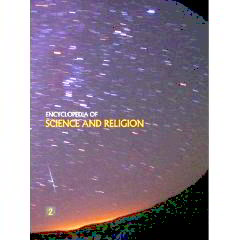|
|
|
|
|
10,7 Mb
|
 |
| Preface
The dialogue between science and religion is one of the most prominent and visible discourses of our time. The complex but enduring relationship between the sciences and diverse world religions has now transformed itself into what some are calling a new scholarly field of science and religion. This multifaceted conversation has developed into a sustained and dynamic discourse with direct implications for contemporary culture. This discourse affects all religions, in both their intellectual and social dimensions. It also analyzes, supports, and constrains the global impact of the sciences of our times. The Encyclopedia of Science and Religion reflects the breathtaking scope and pluralistic character of this ongoing dialogue. It is the most comprehensive work of its kind, and it is designed to be accessible to a wide readership from high school students to independent researchers and academics. Anyone fascinated by the ever-evolving impact of the sciences on religious belief in a global context will find the Encyclopedia a rich resource, for the historical relationship between science and religion certainly ranges from harmony and mutual support to stormy periods of intense conflict. In the last two decades public awareness of and interest in this complex and often contentious relationship between science and religion has reached an unprecedented level. Courses in science and religion are now taught worldwide at a great number of educational institutions. Centers for the study of science and religion are actively pursuing the challenges and complexities of this dialogue; local and international societies for science and religion have been, and are being, established. There is also an exploding number of publications, journals, newsletters, and papers. Most recently, the science and religion dialogue has established an impressive new presence on the Internet. All of these issues, interests, and constituencies are reflected in the Encyclopedia of Science and Religion. The challenging conversation between the sciences and religions is highlighted with entries focusing on issues that bear on topics such as behavioral studies and the human sciences; cognitive science and the neurosciences; computer science and information technology; physical sciences and cosmology; ecology; ethics and value theory; evolution; genetics; feminist and womanist issues; mathematics; methodology; medicine; philosophy; biology; paleontology and the anthropological sciences; and technology. World religions as varied as Bahá'í, Buddhism, Chinese religions, Christianity, Hinduism, Islam, Judaism, and Shinto are represented with individual entries or clusters of entries. There are more than four hundred entries in the Encyclopedia of Science and Religion, all arranged in alphabetical order for easy reference. The entries range in length from several thousand words on broad topics, to a hundred words or so for key terms in the various sciences and religions. The editors see this work primarily as a reflection on the most important issues in the contemporary dialogue between the sciences and religions. A glance over the list of entries, however, indicates that the Encyclopedia also covers the critical history of the relationship between science and religion and offers historical biographies of a select number of important figures. All entries guide readers to further sources of information and exhaustive cross-references quickly and easily lead to related topics. The authority of the Encyclopedia is assured by the experts who have written the entries. The authors have written so as to make this Encyclopedia accessible for students in general, for the public at large, and for scholars in a variety of disciplines. In this way we have created a rich reference resource that is well suited to diverse library environments. The frontmatter features a Synoptic Outline, covering the complete scope and every entry of the Encyclopedia of Science and Religion. The purpose of this Outline is to make the Encyclopedia even more accessible by grouping all entries into broad, topical categories. Teachers and readers are offered an organized map of the whole field of science and religion. In addition, a comprehensive Index provides readers with yet another means of access to the wealth of information contained in these two volumes, while an Annotated Bibliography of selected works introduces readers to those published works currently regarded as indispensable in the field of science and religion. The editors would like to thank Ian Barbour, one of the most prominent scholars in the field, for graciously agreeing to act as a consultant at the initial planning phase of the Encyclopedia of Science and Religion. His advice was invaluable to us. We also thank the expert staff at Macmillan Reference USA for their outstanding support throughout this project. We extend our appreciation to the following persons at Macmillan: Elly Dickason, former publisher of Macmillan, for her initiative and encouragement at the beginning of this project; Michael McGandy, who was a pleasure to work with, and who guided us with unfailing professionalism and expertise; Hélène Potter, who oversaw the project with great vision, and was responsible in the end for pulling everything together; and Judy Culligan for all her hard work and a very professional level of copy editing. Here at the Princeton Theological Seminary my assistant Ryan Valentine did an outstanding job. He devoted a great deal of time developing the database that was critical to the beginning phase of this project and later assisted in the editing process. He was also responsible for preparing the Synoptic Outline and checking all cross-references. Taede Smedes did a first rate job of helping us put together the Annotated Bibliography. The editors, finally, would like to express our deep gratitude to family members and loved ones who so consistently acknowledged and supported our work on this project. J. WENTZEL VREDE VAN HUYSSTEEN |